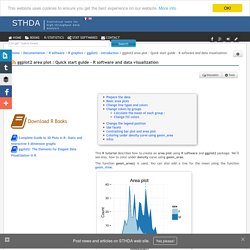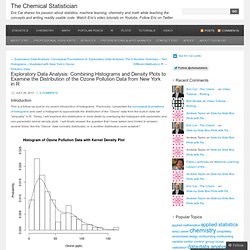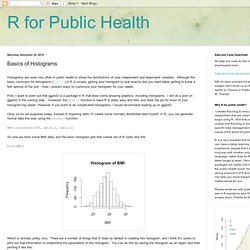

Ggplot2 area plot : Quick start guide - R software and data visualization. This R tutorial describes how to create an area plot using R software and ggplot2 package.

We’ll see also, how to color under density curve using geom_area. The function geom_area() is used. You can also add a line for the mean using the function geom_vline. This data will be used for the examples below : set.seed(1234) df <- data.frame( sex=factor(rep(c("F", "M"), each=200)), weight=round(c(rnorm(200, mean=55, sd=5), rnorm(200, mean=65, sd=5))) ) head(df) ## sex weight ## 1 F 49 ## 2 F 56 ## 3 F 60 ## 4 F 43 ## 5 F 57 ## 6 F 58. Legend to density plot with multiple groups. GgPlot2: Histogram with jittered stripchart. Here is an example of a Histogram plot, with a stripchart (vertically jittered) along the x side of the plot.

Alternatively, using the geom_rug function: Of course this simplicistic method need to be adjusted in vertical position of the stripchart or rugchart (y=-2, here), and the relative proportion of points jittering. Exploratory Data Analysis: Combining Histograms and Density Plots to Examine the Distribution of the Ozone Pollution Data from New York in R. Introduction This is a follow-up post to my recent introduction of histograms.

Previously, I presented the conceptual foundations of histograms and used a histogram to approximate the distribution of the “Ozone” data from the built-in data set “airquality” in R. Today, I will examine this distribution in more detail by overlaying the histogram with parametric and non-parametric kernel density plots. I will finally answer the question that I have asked (and hinted to answer) several times: Are the “Ozone” data normally distributed, or is another distribution more suitable? Read the rest of this post to learn how to combine histograms with density curves like this above plot!
This is another post in my continuing series on exploratory data analysis (EDA). Getting the Data and Summary Statistics Before plotting the histograms and density curves, let’s get the data and calculate the summary statistics. Kernel Density Plot: A First Non-Parametric Approximation Start with the Normal where. Density Plot with ggplot. This is a follow on from the post Using apply sapply and lappy in R.

The dataset we are using was created like so: m <- matrix(data=cbind(rnorm(30, 0), rnorm(30, 2), rnorm(30, 5)), nrow=30, ncol=3) Three columns of 30 observations, normally distributed with means of 0, 2 and 5. We want a density plot to compare the distributions of the three columns using ggplot. First let's give our matrix some column names: colnames(m) <- c('method1', 'method2', 'method3') head(m) # method1 method2 method3 ggplot has a nice function to display just what we were after geom_density and it's counterpart stat_density which has more examples. ggplot likes to work on data frames and we have a matrix, so let's fix that first df <- as.data.frame(m) df Enter stack. R for Public Health: Basics of Histograms. Histograms are used very often in public health to show the distributions of your independent and dependent variables.

Although the basic command for histograms (hist()) in R is simple, getting your histogram to look exactly like you want takes getting to know a few options of the plot. Here I present ways to customize your histogram for your needs. First, I want to point out that ggplot2 is a package in R that does some amazing graphics, including histograms. I will do a post on ggplot2 in the coming year. However, the hist() function in base R is really easy and fast, and does the job for most of your histogram-ing needs.
Okay so for our purposes today, instead of importing data, I'll create some normally distributed data myself. BMI<-rnorm(n=1000, m=24.2, sd=2.2) So now we have some BMI data, and the basic histogram plot that comes out of R looks like this: hist(BMI) Which is actually pretty nice. Histinfo<-hist(BMI)histinfo And you get the output below: 1. 2. Notice the y-axis now. 3. Back to back histogram. Data Analysis and Visualization in R: Overlapping Histogram in R. While preparing a class exercise involving the use of overlaying of histogram, I searched Google on possible article or discussion on the said topic.

Luckily, I found a blog where the author demonstrated an R function to create an overlapping histogram. However, a comment from a guy also showed the same output using transparency. Below were the sample codes that can be used to generate overlapping histogram in R as based on the blog and the viewers comment.